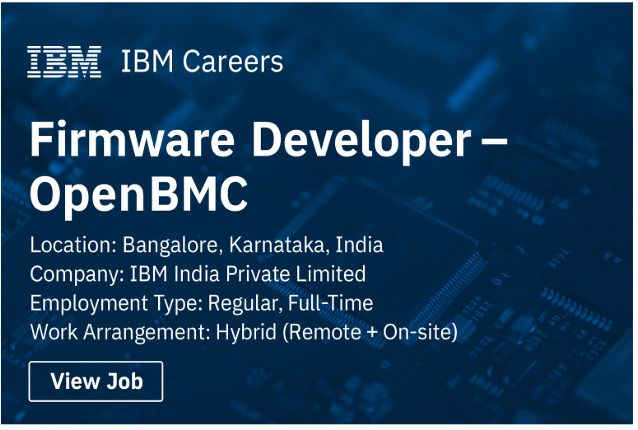IBM Careers: Firmware Developer – OpenBMC | C++ & Embedded Linux | Hybrid Bangalore Job
IBM Careers: Firmware Developer – OpenBMC | Hybrid Role in Bangalore
Shape Next‑Gen Server Control with IBM’s OpenBMC Team
Position Title: Firmware Developer – OpenBMC
Location: Bangalore, Karnataka, India
Company: IBM India Private Limited
Employment Type: Regular, Full‑Time
Work Arrangement: Hybrid (Remote + On‑site)
Department: Power Software Development | Infrastructure & Technology
Shift: General Daytime
Job ID: 26961
Why This Role Matters
IBM’s Power Systems are redefining enterprise server capabilities with intelligence, flexibility, and reliability. At the heart of this innovation lies OpenBMC, an open-source firmware stack that powers next-generation servers. As an OpenBMC Firmware Developer, you’ll contribute to sophisticated firmware layers responsible for booting, monitoring, and managing systems. This role enables you to work at the crunch point between hardware and software, shaping the control plane that keeps mission-critical servers running smoothly.
Your Role & Responsibilities
Join the World‑Wide Firmware Development Team in Bangalore to design and implement advanced firmware features on Power servers. You will:
-
Design and develop critical features in C++ using Modern C++ standards (C++17/20), leveraging skills in STL, design patterns, and data structures.
-
Engage with the Linux OS at a firmware level, including drivers, kernel modules, and system calls.
-
Work with open-source tools like Git, Gerrit, Jenkins, Perl, Python, and BitBake to manage code, build firmware, and automate workflows.
-
Debug complex issues caused by hardware or firmware interactions.
-
Drive development using agile principles, collaborating with global teams across ISDL.
-
Develop firmware features that manage server hardware, including sensor monitoring, power management, and device trees for I2C/SPI/GPIO control.
-
Optionally build hardware abstraction layers and expose server control via Redfish APIs and RESTful services.
-
Build firmware that supports server boot, monitoring, diagnostics, and recovery functions.
Required Qualifications & Expertise
-
Educational Requirements:
-
Bachelor’s Degree in Computer Science, Electronics, or a related technical field (required)
-
Master’s Degree (preferred)
-
-
Experience:
-
2–10 years of firmware or low-level software development experience
-
Solid command of Modern C++ (C++11–20), including design patterns and data structures
-
Strong Linux OS fundamentals, scripting, and debugging tools
-
Excellent problem-solving and debugging capability
-
Preferred Qualifications
-
OpenBMC stack experience
-
Familiarity with Redfish, REST/HTTP, and secure web services
-
Expertise in device tree management and HAL wrappers for hardware protocols (GPIO, I2C, SPI)
-
Networking knowledge: socket programming, SSL, Linux firewall rules
-
Experience in C++17/20 modern constructs
-
Exposure to server hardware bring-up and power/sensor management
What You’ll Work On
Your firmware innovations will directly support IBM’s mission to deliver secure, efficient, and AI-enhanced servers across industries—from banking and healthcare to aerospace and research. You’ll deliver features such as:
-
Secure bootguard and firmware chain-of-trust
-
OpenBMC modules for sensor polling, watchdog timers, and fan control
-
HAL extensions that expose hardware-specific protocols to the firmware
-
RESTful Redfish interfaces for remote management
Skills & Competencies
Technical:
-
Deep expertise in C++17/20, open-source firmware, and hardware interaction
-
Firmware debugging: gdb, kernel logs, hardware counters
-
Mastery of Linux kernel internals and embedded system calls
-
Experience with DevOps tools—Git, Gerrit, Jenkins (CI/CD)
-
Experience with BitBake and Yocto layers for firmware delivery
-
Knowledge of hardware bring-up, specifically for sensors and buses
Interpersonal:
-
Strong communication—able to work with hardware architects, firmware engineers, and system integrators
-
Analytical mindset for problem-solving across hardware-software boundaries
-
Proactive self-starter who thrives in agile environments
-
Team-oriented with respect for global perspectives and cultural diversity
Why Join IBM’s Firmware Team
1. Be Close to Hardware & Software
Develop low-level firmware that interfaces with processors, sensors, and buses—building the control layer that orchestrates entire server systems.
2. Open Source Innovation
3. Global Collaboration
Join a global firmware team interacting with engineers across IBM Systems, aiding seamless server operations and intelligent infrastructure.
4. Career Growth & Learning
Access to IBM’s training platforms, certifications, and R&D interactions in embedded systems, Linux, IoT, and firmware security.
Life @ IBM
IBM values creativity, curiosity, and innovation. As an OpenBMC Developer, you’ll benefit from:
-
Learning Culture: Ongoing access to technical training, mentorship, and expert collaboration
-
Diversity & Inclusion: A globally trusted workplace that values inclusive thinking
-
Impactful Work: Your firmware tools will run enterprise servers powering global economies
IBM’s Long‑Term Vision
Open BMC firmware is critical to unlocking intelligent operations at the hardware level—ensuring servers boot securely, update reliably, and recover gracefully.
Equal Opportunity & Inclusion
Diversified teams are core to innovation.
How to Apply
-
Tailor your resume highlighting: C++ firmware, OpenBMC, Linux drivers, BitBake, scripting, debugging, hardware interfaces
-
Apply only to relevant roles—limit to 3 IBM applications per year
-
Expect hardware/software coding assessments, firmware debug demos, and scenario interviews
-
Follow up with IBM’s recruiting team and connect on LinkedIn for insights
Final Thoughts
If you are passionate about embedded systems, firmware, Linux internals, and open-source innovation, this role offers an impactful stage. You’ll build intelligent firmware that powers the world’s most advanced servers and cloud infrastructure.
🔧 Apply today and become an IBMer shaping the firmware foundation of tomorrow’s enterprise systems.

